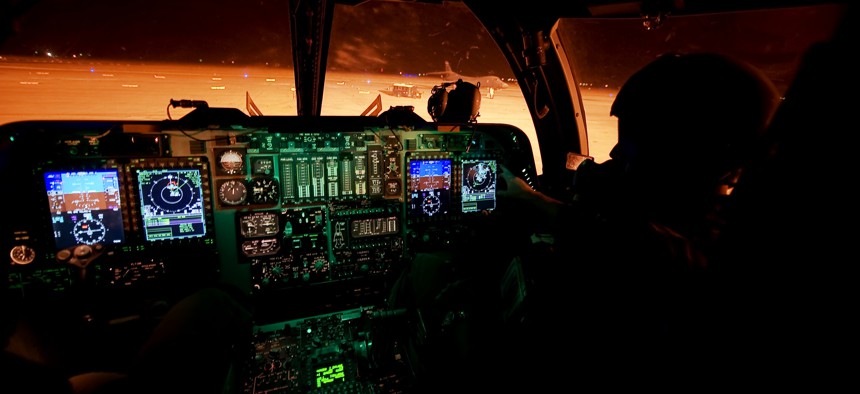
The cockpit of a B-1B bomber at Dyess Air Force Base, Texas. Staff Sgt. Richard Ebensberger/USAF
Did Your Company Make that Warplane? Don’t Count on the Upgrade Work Anymore
The new Air Force acquisition chief wants to open more sustainment contracts to competition.
The Pentagon spends roughly twice as much to operate, maintain, and upgrade its arsenal than it does to buy the weapons in the first place — and the Air Force’s new head of acquisition says that’s partly because too few of the contracts are awarded competitively.
Will Roper wants that to change. No longer should the firm that built a specific weapon or part automatically get the contracts to oversee its repairs and upgrades.
“I would like to be able for a system to continually compete, replace and upgrade, all the different components,” Roper told reporters Friday at the Pentagon.
That’s largely how the commercial sector does it, he said. By contrast, some defense manufacturers have held the sustainment contracts on their weapons for decades.
So the Air Force has begun asking its suppliers for the source codes and other data on their products — the kind of information that would allow the service to take a sustainment contract that has long belonged to the manufacturer and throw it up for bids.
“If if get locked into the [intellectual property] in the architecture so that I can’t change things anymore, now I’m not in a very competitive aspect in the government and I can’t encourage competition in industry,” Roper said. “I would like to be able to own the architecture and the interface, have them be truly open and somehow be able to enforce that so I can change things.”
This change is rattling the defense industry. In February, Lockheed Martin — the world’s largest defense firm — protested an Air Force request for data related to its Sikorsky Black Hawk helicopter. The helicopter is a candidate to replace old Air Force Huey helicopters used to guard intercontinental ballistic missiles fields in the northern U.S.
The Air Force has asked bidders for “far more data than I’ll say the Army is using today to support those aircraft in the fleet,” Bruce Tanner, Lockheed Martin CFO, said last week on the company’s quarterly earnings call.
“It’s a little puzzling as to why the same helicopter would have two different requirements for intellectual property when the government is already supporting that aircraft through the Army depots,” Tanner said. “It’s just a little bit of a head-scratcher sometimes. Oftentimes, these are existing platforms with a new request for intellectual property that’s a little puzzling.”
Lockheed chairman-CEO-president Marillyn Hewson said the Pentagon has begun making “unbounded requests for all of the intellectual property rights” for components within the supply chain.
In the Huey competition, she said, Lockheed protested even before the contract was awarded “because we could not get to a position with the U.S. government in the dialogue up to that point to be comfortable that we could certify that we could provide all of the intellectual property that they requested, because we couldn’t certify that we could bring forth all of that for some of our subcontractors.”
Fixing and maintaining airplanes is a big business. Last year, Boeing — America’s largest aerospace firm — stood up a services division as it pushes for a bigger share of the repair market for commercial and military aircraft.
Roper wants more competition throughout the life of a military weapon. He acknowledged this “may be high hopes for acquisition, but it should be tried. But there’s a part of me that feels like for industry that would be a better model too, because there would be a lot more competition.”
He said the Pentagon push for innovation has largely been centered on the development phase of weapons, not on the sustainment side.
“I’m looking to innovate wherever there’s a problem,” he said. “Sustainment has problems. We have aircraft on the ground that should be in the air.”
Specifically, Roper wants to use technologies like 3-D printed parts and predictive maintenance to lower the cost of upgrades and perform maintenance more efficiently.
“Not fixing something after it’s broken, but predicting when it’s going to break and fixing it ahead of time,” he said. “All of us probably get our oil changed before the car breaks down. There’s a reason why you do it where it says on the mile marker. That’s just good practice that we should have in the Air Force.”
He also touted using artificial intelligence to better manage supply lines.
“Designing for sustainment is a thing that we should really focus on,” Roper said.
The Air Force plans to hold an “acquisition day” next month where the sustainment of weapons is expected to be discussed.
“We have to find a way to incentivize and make this the best way for them to do business with is,” Roper said. “I haven't been able to delve into it, but my gut says we have not incentivized this behavior properly and therefore we haven’t gotten it.”





